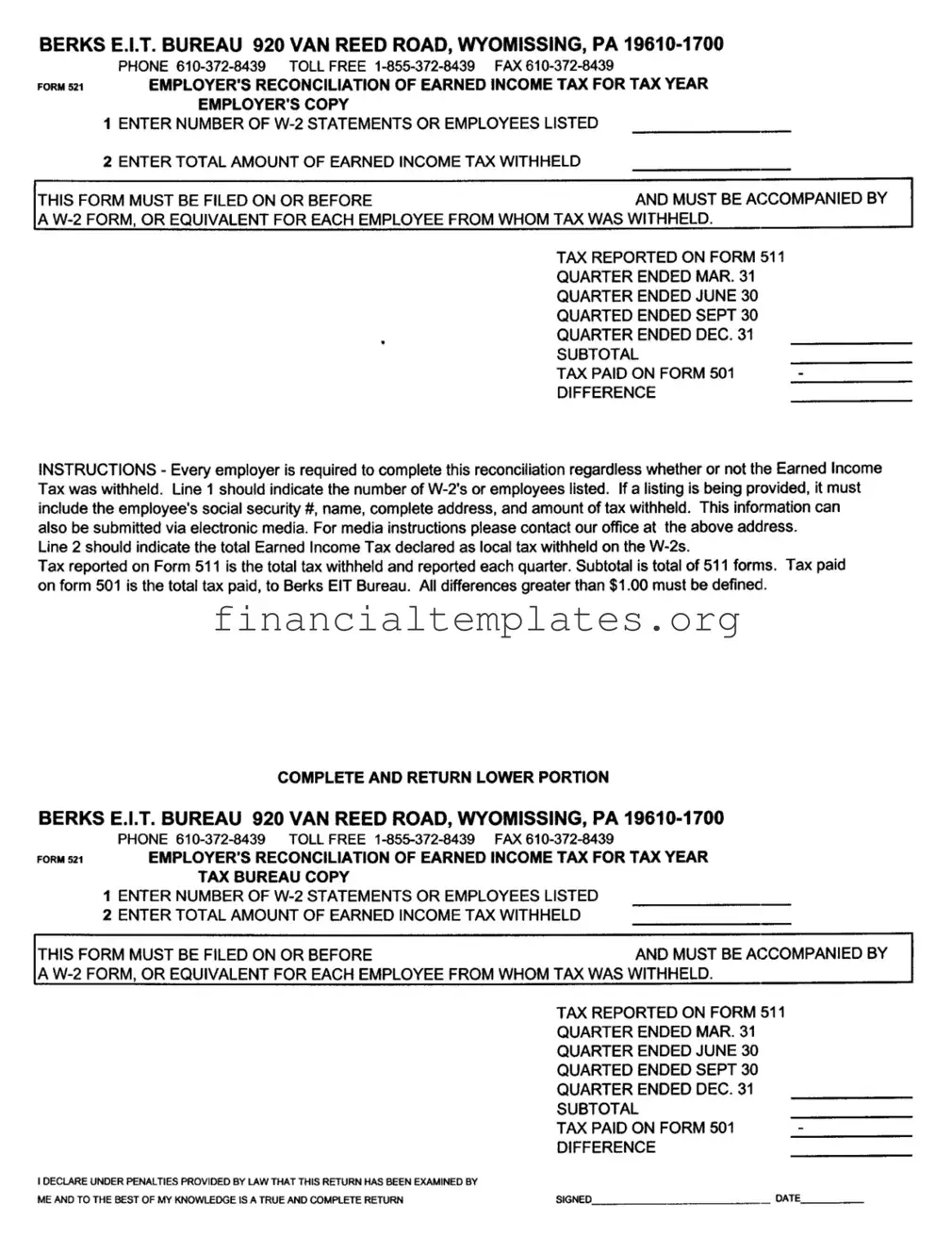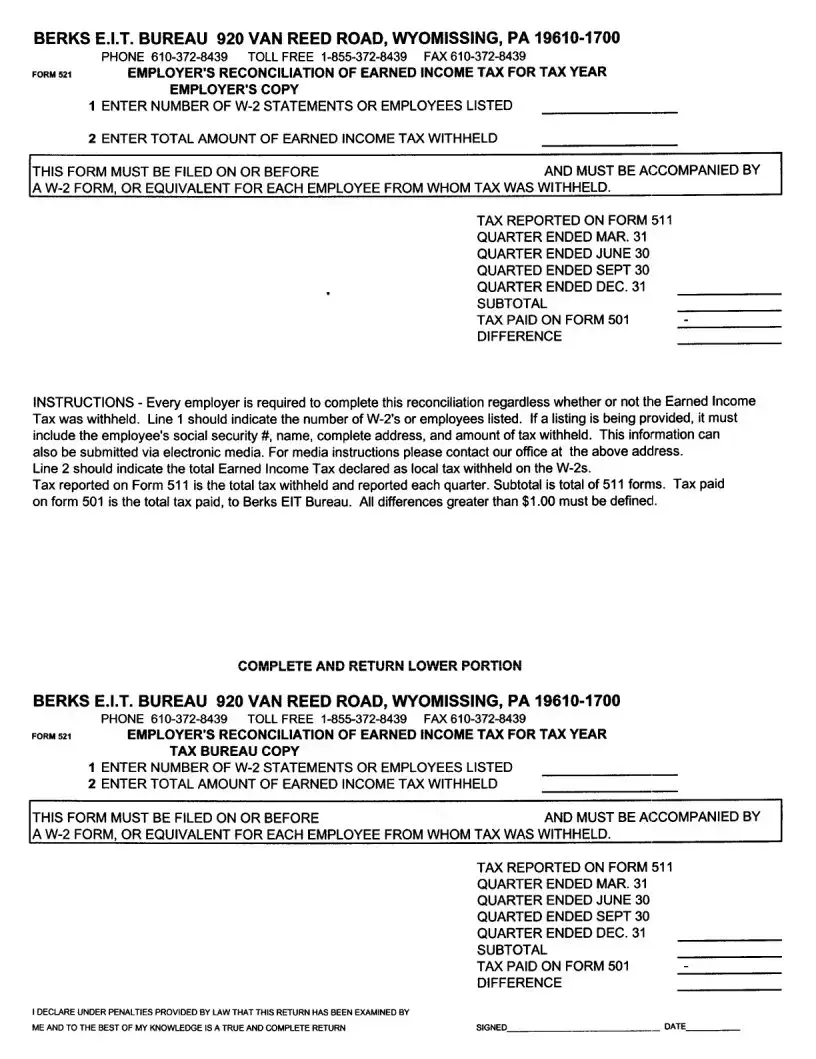The Internal Revenue Service (IRS) Form W-2, commonly known as the Wage and Tax Statement, has a close resemblance to the Berks Tax form, particularly in its purpose of reporting income and taxes withheld. Similar to the Berks Tax form which collects details about the earned income tax withheld by an employer, the W-2 form captures an employee's annual wages and the amount of taxes withheld from their paycheck for federal and state tax purposes. Both documents serve as essential tools for reconciling the tax withheld from the employee's income with the actual tax liability.
IRS Form 941, the Employer's Quarterly Federal Tax Return, shares similarities with the Berks Tax form in its periodic reporting requirement. While Form 941 is used to report wages paid, federal income tax withheld, and both the employer's and employee's share of social security and Medicare taxes on a quarterly basis, the Berks form focuses on local earned income tax reconciliation for employers. Both forms are pivotal for ensuring tax compliance and accurate payroll tax reporting by employers.
Form PA-W3, the Pennsylvania Employer Quarterly Return of Income Tax Withheld, like the Berks Tax form, is tailored for reporting state-level income tax withholding. Employers use Form PA-W3 to reconcile the state income tax withheld from employees' wages each quarter, echoing the Berks form's role in reconciling local earned income tax. Both documents aid in the accurate calculation and reporting of taxes withheld, ensuring that employers meet their tax reporting obligations at their respective jurisdictional levels.
The Unemployment Compensation (UC) Quarterly Tax Return is another document with similarities to the Berks Tax form, focusing instead on unemployment tax contributions rather than income tax withheld. Employers report their wages paid and unemployment taxes due each quarter, akin to the way earned income tax details are provided in the Berks Tax reconciliation. Both forms play a crucial role in funding governmental programs, whether for unemployment benefits or local infrastructure through tax revenue.
Form 940, the Employer's Annual Federal Unemployment (FUTA) Tax Return, compares to the Berks Tax form by handling a different aspect of employment taxation on an annual basis. Form 940 calculates the employer's federal unemployment tax liability on the wages paid. The principle of reconciling taxes collected from the operational activity of employees underlines both the FUTA tax and the local earned income tax obligations covered by the Berks document.
Form 1042, the Annual Withholding Tax Return for U.S. Source Income of Foreign Persons, has parallels with the Berks form in its approach to withholding tax, albeit focusing on nonresident aliens and foreign entities. Just as the Berks form is critical for local tax compliance through the reconciliation of earned income tax, Form 1042 ensures compliance with U.S. tax law on payments made to non-U.S. persons, highlighting the breadth of tax reporting responsibilities for different entities and jurisdictions.
The Quarterly Federal Excise Tax Return, or Form 720, shares the concept of periodic tax reporting with the Berks Tax form, but diverges in focusing on goods and services subject to excise taxes. The principle of reporting tax obligations on a regular basis underpins both documents, ensuring ongoing compliance and remittance of taxes that support federal, state, or local government functions.
Local Services Tax (LST) returns, required in some Pennsylvania jurisdictions, demonstrate parallels to the Berks Tax form by focusing on a specific tax that benefits local services. Employers are responsible for withholding the LST from employees and reporting those withholdings, similar to the way earned income tax withholdings are reported on the Berks form. Both forms facilitate the funding of essential community services through tax revenue.
Form 1099-MISC, Miscellaneous Income, and its successor, Form 1099-NEC, for reporting non-employee compensation, share a kindred purpose with the Berks Tax form in tax reporting. Although primarily used for independent contractors rather than traditional employees, these forms involve the reporting of payments and, in some cases, federal tax withholdings, paralleling the Berks form's focus on income tax withheld by employers but applied to a different type of worker.
Finally, the Schedule H (Form 1040), Household Employment Taxes, resembles the Berks Tax form in its application for employers, albeit in a domestic context. Users of Schedule H must report taxes related to household employees, similar to how the Berks form is used for reconciling earned income taxes for business employees. Both documents underscore the responsibility of employers to accurately report and remit taxes on wages paid.

